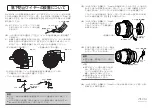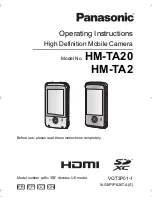
Manual
BRESSER MikroCam PRO HDMI
Item.-No. 5914180
1) AC adapter socket
2) On/Off Button
3) Status-LED
4) SD Card Slot
5) HDMI-port
6) USB-port
Setup of the camera
Connect the AC adapter with the camera (1) and plug it into the wall socket. The Status-LED (3) lights up red.
Plug the USB cable from the mouse into the camera (6).
Put a SD card into the slot (4). Make sure the SD card is put in correctly and is fully plugged in (it clicks into place).
Without the mouse, the camera is in Auto mode. You are not able to change parameters (e.g. exposure time).
Without SD card, you will get an HDMI live image, but no images or videos can be saved.
Connecting the camera to a microscope
The BRESSER MikroCam PRO HDMI has a C-Mount adapter thread. This makes it compatible to many different microscopes and adapters.
BRESSER offers two different adapters:
- C-Mount MikroCam Adapter (Art.-Nr. 5942101), fits all BRESSER microscopes of the “Science” range, including the “BioScience”model.
- reduction lens 0.5x variable (Art.-Nr. 5914005), fits all microscopes with 23,3mm eyepiece diameter or 23,2mm camera tubes.
The C-Mount MikroCam Adapter is threaded into the camera and is placed into the “Science” microscope camera tube socket. It is secured
with a locking screw.
The reduction lens 0.5x variable is threaded into the camera. It is put directly into the eyepiece tube or camera tube. The silver ring is turned to
adjust focus or change the field of view.
NOTE:
The BRESSER MikroCam PRO HDMI will show a smaller field of view than is visible in 10x eyepieces.
Connect the camera to a TV screen or Monitor
The BRESSER MikroCam PRO HDMI can be connected directly to a TV screen or computer monitor with HDMI inlet. To connect it, plug the
supplied HDMI cable into the socket (5) of the camera and into the respective socket of your TV or computer monitor. Some monitors may
have only a DVI socket, which can also be used with a HDMI/DVI adapter, but this adapter is not included with the camera.
To receive the live picture, it might be necessary to select the HDMI port on your TV or monitor. Consult the respective manual on how to do
this.
Start the camera by pressing the ON/OFF-button (2). The Status-LED (3) lights up in blue. It takes a few seconds for the camera to start. After
startup, you should see a live image on the screen.
If the live image is not sharp, use the focus knob on your microscope to adjust it.
Control the camera with the mouse
If the mouse is connected to the camera, you can activate the on screen display by moving the mouse pointer to the left or downmost edge of
the monitor. The camera control panel will show.
Camera Control Panel (left side of the screen)
All control sliders highlighted in blue can be adjusted with the mouse. To change a value, click and hold the mouse pointer on the slider while
moving it to the desired position, then release the mouse button.
Snap:
To aquire an image, click this button. A SD card must be inserted in the camera.
Record:
To start saing a video, click the record button. To stop recording, click again. A SD card must be inserted in the camera.
Auto Exposure:
When this function is activated, exposure time and amplification (Gain) is set automatically from the camera.
Exposure Target:
When the function “Auto Exposure” is activated, you can adjust the image brightness with the “Exposure Target” slider. All
other functions stay in auto mode.
When deactivating the function „Auto Exposure“, you can fully adjust the following parameters:




















